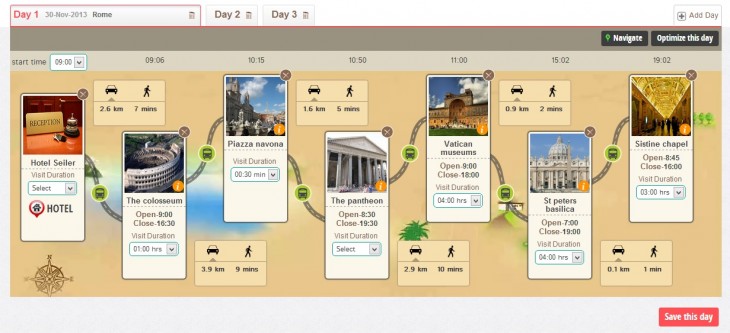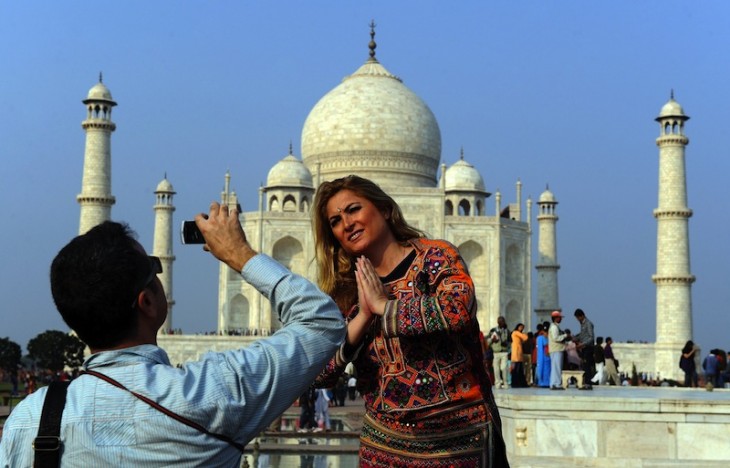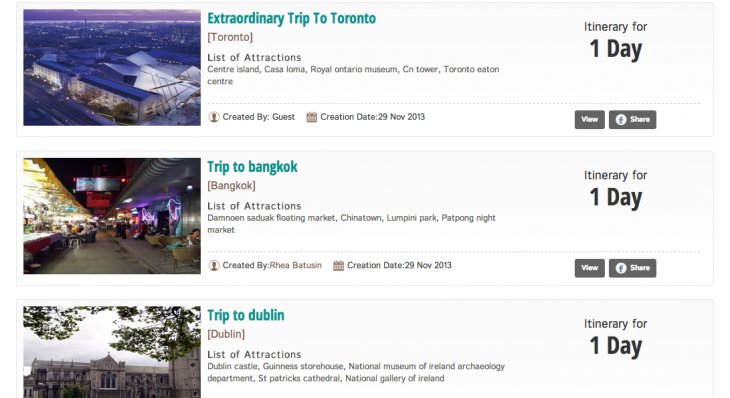
Coming up with an itinerary for your holiday can be a headache-inducing task — after all, it takes so much effort to plan which attractions you would like to visit, the best way to get to your various destinations within the opening hours, and how much you need to pay at each place.
JoGuru, a travel startup based in India, conducted some research on over 12,000 travelers in cities like Paris, London, New York, Delhi, Mumbai and Singapore — and found that on average, a regular traveler has to browse about eight to 20 websites, key in anything from five to 40 queries on Google, and ask up to three questions on forums or social networking websites such as TripAdvisor. All in all, this adds up to anything from two hours to two weeks of time spent planning.
JoGuru aims to solve this problem with a very visual solution: it displays a map with whatever attractions you have selected, and optimizes your travel route with an algorithm — basically arranging the sequence of your attraction visits according to the distance between them and their opening and closing times.
Speaking with JoGuru CEO and co-founder Praveen Kumar recently, I appreciated the fact that the site is a useful tool for trip planning, but felt there were key elements missing that would be particularly helpful for planning an itinerary — such as hotel locations.
And lo and behold, JoGuru has since added Expedia-powered hotel listings to its website. Users not only get to add hotels to their travel route, but also get to book them directly via JoGuru. Monetization also kicks in here, as JoGuru gets a 5-15 percent cut if the payment for the hotel goes through.
And that’s not the end of it. Kumar tells TNW that it plans for JoGuru to “become an end to end travel planning platform integrated with booking engines for hotels, flights, experiences, car rentals etc.”
JoGuru versus its competitors
The use of an optimizing algorithm is clearly JoGuru’s strong point. Kumar acknowledges the existence of strong (and much more established) competitors in the itinerary planning space such as Tripomatic and Plnnr.
However, the convenience of being able to select whatever attractions you want to visit and let JoGuru do the rest of the legwork is probably very appealing for the time-pressed travelers — you get control right from the start over which attractions you want to see and on which day, but you don’t have to plan how to get from one place to the other. Currently, users can also select and book hotels that would fit in with their itinerary, as they are also optimized for distance.
Another plus point for JoGuru is its simple visual interface, which makes it much easier to absorb compared with other trip planners that draw your route out on city maps.
JoGuru currently lists content for 960 cities from more than 150 countries, in the form of City and Attraction pages, but the itinerary planning feature — which comes about only after JoGuru formats and curates the content accordingly into its algorithms — is available for 70 cities currently.
The site will, however, be scaling this up to cover all the 960 cities next year.
Overcoming challenges will bring JoGuru far
JoGuru’s itinerary feature has been live since August this year, and it currently has about 70,000 monthly active users — a figure that Kumar says has been increasing at about 100 percent month-on-month over the last six months.
User acquisition will be key for JoGuru going forward — although the content on the site is owned by the company after 15 months researching and aggregating it, Kumar notes that users “do form a very strong source of content.” After all, JoGuru terms itself as a “social travel network” where users get to share their itineraries as well.
Kumar also acknowledges that JoGuru faces several challenges — building a database of the logistical content of all the top attractions of the world requires constant verification, and providing a seamless experience to users by integrating with partners such as hotel booking engines and review sites needs time and plenty of effort.
There is still some way to go before JoGuru becomes the go-to portal for itinerary planning — after all, there are elements still missing such as the inclusion of airport listings — but its simple design is much easier on the eye compared with many of its competitors and the optimization algorithm is really nifty. If JoGuru continues beefing up its site with more useful content, it could well be on its way to become a must-have travel planner for tourists all over the world.
➤ JoGuru
Headline image via Ishara S.KODIKARA/AFP/Getty Images, other image via Getty Images
Get the TNW newsletter
Get the most important tech news in your inbox each week.








